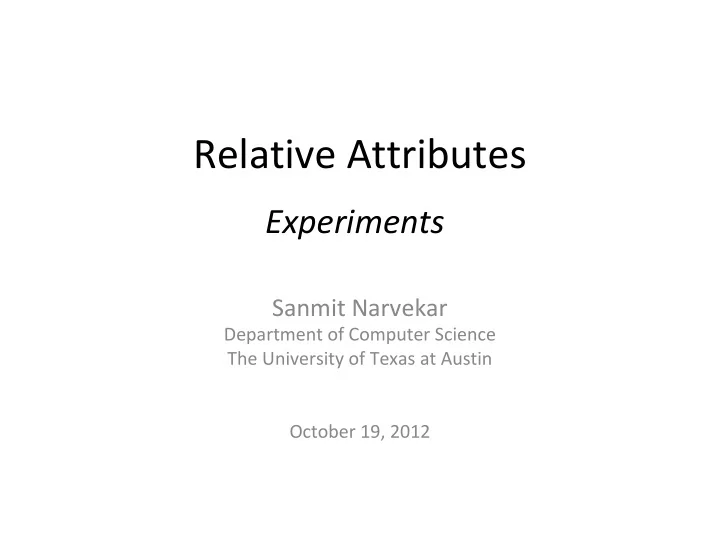

Relative Attributes Experiments Sanmit Narvekar Department of Computer Science The University of Texas at Austin October 19, 2012
Overview Test Image & Descriptors Image Descriptor (GIST) Training Images & Categories Ordered Pairs (O m ) Rank SVM Attributes Un-ordered Pairs (S m ) Attribute Scores 1. How does the type of “pairs” supervision given affect how well an attribute is learned? 2. Do we need a continuous relative ranking, or would discrete work better? 3. How do we know whether the attributes are learning the features they correspond to?
Analyzing Type of Supervision The paper does this • Category-level training pairs – Easy to obtain more pairs, which may not all be “correct” • Instance-level training pairs – Harder to obtain, but more “correct” Categories are different people or scene types
Analyzing Type of Supervision • Compare which attributes perform better for which type of supervision • Masculinity and smiling • Naturalness and openness • Evaluated on 10 random pairs of images Accuracies Masculinity Smiling Naturalness Openness Categorical 0.90 0.70 Categorical 0.90 0.80 Instance 0.80 0.70 Instance 0.80 0.90 Faces Dataset Scenes Dataset
Masculinity and Smiling Smiling Categorical -0.1354 0.1155 Instance 0.1091 0.0852 Miley usually smiles more than Alex, so the categorically trained classifier got confused Attributes that vary within classes are trained better on instances
Masculinity and Smiling Smiling Categorical -0.2777 0.0697 Instance 0.0384 -0.1093 Occlusion interferes with the inference. But, we know Miley usually smiles more than Alex. Does this count?
Masculinity and Smiling Masculinity Categorical -0.1211 0.0829 SAME Instance 0.7310 0.4664 PERSON?! Masculinity is technically a categorical attribute However, even categorical attributes can vary intra-class in unexpected ways
Naturalness and Openness Naturalness Categorical 0.5463 -0.0561 Instance 0.2931 -0.0162 And some things inevitably come down to taste
Need for Relative Attributes • Do we really need continuous relative attributes? OR • Do some attributes form distinct groups? – male vs. female – natural vs. artificial – Could be more than 2 groups… – Then use a discrete ranking system? Analyze the histogram of rankings across attributes and their mean shift cluster centers
Relative Attributes (OSR) Natural Open Mean shift clusters (0.4013, -2.5863) (-0.1120, -1.3116) Close Large size depth (-0.8582) (0.9771, 0.2566) Most rankings have a Gaussian-like distribution, suggesting attributes are more amenable to representation by relative rankings rather than binary or discrete rankings
Relative Attributes (PubFig) Male Smiling Gaussian even (0.5728) (-0.0110) for “intrinsically” categorical attributes Young Chubby (-0.1543) (-0.1151) In distributions where a lot of the mass is in the middle, binary attribute labels (representing the extrema) could be inappropriate
Attribute Localization • How do you know whether the attributes learned correspond to their semantic meanings? – Especially when no labels, bounding boxes, etc. given Object recognition Attribute-based recognition Learning airplane or sky? Learning high heels or no laces? Seems more problematic in attribute-based recognition, since each attribute has semantic meaning, and is a part of a whole that can be hard to identify
Attribute Localization • Task : Determine whether the ranker is learning the attribute “high heels” in a dataset of shoes • Approach : Descriptor of heel area Descriptor of whole image Compare results of rankers trained on these different types
Attribute Localization • Evaluate on 10 random pairs of images • Images are automatically flipped if facing the wrong way • Compare how well each method ranks high heels given – Image descriptor of the whole image – Image descriptor of only the heel area – Image descriptor of everything except the heel area Accuracies Whole Image Relevant Area Irrelevant Area 1.00 0.80 0.50 Suggests some contextual information was used for classification
Find the Highest Heel Whole 0.6742 -0.6160 Relevant -0.0342 -0.1440 Irrelevant -0.1146 -0.0074 The “whole” and “relevant” descriptors both saw the missing heel in the right-side shoe The straps might have mislead the “irrelevant area” classifier?
Find the Highest Heel Whole 1.3252 1.8974 Relevant -0.0154 -0.0181 Irrelevant 0.0612 -0.0910 The ranker fed the whole image descriptor could probably reason about heel height from the sole, since the heel itself was occluded. Attribute captured, not captured, or assisted?
Summary We looked at: • Types of supervision, and its effects on attributes intrinsic to a class (masculinity) and where they can vary (smiling) – Category-level supervision – Instance-level supervision • Need for continuous relative attributes, or whether attributes form “discrete” groups – How that affects different classes • Attribute localization – Are we learning what we think we are?
References • D. Parikh and K. Grauman. Relative Attributes. ICCV 2011. • A. Oliva and A. Torralba. Modeling the shape of the scene: a holistic representation of the spatial envelope. IJCV 2001. • Links to existing code and data used: – GIST: http://people.csail.mit.edu/torralba/code/spatialenvelope/ – Rank SVM: http://ttic.uchicago.edu/~dparikh/relative.html#code – Categorical and Instance Pair labels, extracted feature representations: http://www.cs.utexas.edu/~grauman/research/ datasets.html • Links to primary datasets used: – OSR: http://people.csail.mit.edu/torralba/code/spatialenvelope/ – PubFig: http://www.cs.columbia.edu/CAVE/databases/pubfig/ – Shoes: http://www.cs.utexas.edu/~grauman/research/datasets.html
Questions?
Recommend
More recommend